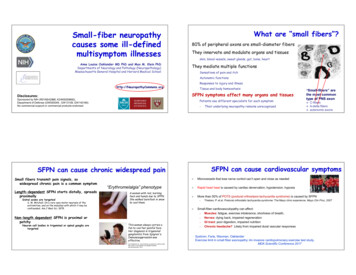
Transcription
Small-fiber neuropathycauses some ill-definedmultisymptom illnessesAnne Louise Oaklander MD PhD and Max M. Klein PhDDepartments of Neurology and Pathology (Neuropathology)Massachusetts General Hospital and Harvard Medical SchoolWhat are “small fibers”?80% of peripheral axons are small-diameter fibersThey innervate and modulate organs and tissuesskin, blood vessels, sweat glands, gut, bone, heartThey mediate multiple functionsSensations of pain and itchAutonomic functionsResponses to injury and illnesshttp://NeuropathyCommons.orgTissue and body homeostasisSFPN symptoms affect many organs and tissuesDisclosures:Sponsored by NIH (R01NS42866, K24NS059892),Department of Defense (GW093049 , GW13109, GW140169)No commercial support or commercial products endorsedPatients see different specialists for each symptom–Their underlying neuropathy remains unrecognized“Small-fibers” arethe most commontype of PNS axon SFPN can cause cardiovascular symptomsSFPN can cause chronic widespread painSmall fibers transmit pain signals, sowidespread chronic pain is a common symptomLength-dependent SFPN starts distally, spreadsproximallyDistal axons are targetedS. W. Mitchell. On a rare vaso-motor neurosis of theextremities, and on the maladies with which it may beconfounded. Am J Med Sci, 1878.Non-length dependent SFPN is proximal orpatchyNeuron cell bodies in trigeminal or spinal ganglia aretargeted“Erythromelalgia” phenotypeA woman with red, burningfeet and hands due to SFPN.She walked barefoot in snowto cool them. Microvessels that lose nerve control can’t open and close as needed Rapid heart beat is caused by cardiac denervation, hypotension, hypoxia More than 50% of POTS (postural orthostasis tachycardia syndrome) is caused by SFPN– This woman always carries afan to cool her painful face.Her diagnosis is trigeminalganglionitis from Sjögren's.Immunosuppression waseffective.from Oaklander AL, Immunotherapy prospects for painful smallfiber sensory neuropathies and ganglionopathies,Neurotherapeutics, 2015C-fibersA-delta fibersautonomic axonsThieben, P. et al. Postural orthostatic tachycardia syndrome: The Mayo clinic experience. Mayo Clin Proc, 2007Small-fiber cardiovasculopathy can affect:–Muscles: fatigue, exercise intolerance, shortness of breath,–Nerves: dying back, impaired regeneration–GI tract: poor digestion, impaired nutrition–Chronic headache? Likely from impaired dural vascular responsesSystrom, Faria, Waxman, OaklanderExercise limit in small fiber axonopathy: An invasive cardiopulmonary exercise test study.MDA Scientific Conference 2017
Top panels – normal control muscleBottom panels – muscle from SFPN patientAxonsSchwanncellsmergeSFPN causes GI symptomsSFPN causes exercise intolerance-weakness, fatigueOften labeled “irritable bowelsyndrome” IBS25% of Gulf War Veteranshave GI symptomsmerge% of Schwann cellprofiles with axonsUpper GI symptoms of SFPN:Nausea and vomiting aftermeals, reflux, esophagealerosions and stricturesLower GI symptoms of SFPN:Constipation, diarrhea, orboth (irritable bowel)Tests for gastrointestinal symptoms of SFPN: Gastric-emptying scintigraphy (below) showsslow emptying of stomach (arrows) Sitz marker study to measure colon transit timefrom: Dori, Lopate, Keeling, Pestronk. Myovascular innervation: axon loss in small-fiber neuropathies. Muscle Nerve, 2015Trail Making AImmediate visual memoryTrail Making BVerbal abstract thinkingTrail Making B-ASpan forwardVisual search: final scoreSpan backwardNeurogenic orthostatic hypotension (POTS)can cause temporary impairment of immediate memory working memorygreen area indicates normative rage values sustained attentionsupine visual searchStanding worsens cognitive functions in patients with neurogenic orthostatic hypotension.head-up tilt abstract thinkingPoda et al., Neurological Sciences, 2012 Many SFPN symptoms improve whenpatients educated about neuropathySFPN affects the brain(who knew?)Capsaicin-sensitive C- and A-fibre nociceptors control long-term potentiation-like pain amplification inhumans. Henrich et al. Brain, 2015Imaging signatures of altered brain responses in small-fiber neuropathy: reduced functionalconnectivity of the limbic system after peripheral nerve degeneration. Hsieh et al. PAIN, 2015Increasing orthostatic stress impairs neurocognitive functioning in chronic fatigue syndrome withpostural tachycardia syndrome. Ocon et al. Clin Sci (Lond), 2012For cardiovascular symptoms–Stand slowly, compression garments–Add salt and fluids to raise BP–Regular exercise–Elevate head of bed with bricks–Improve oxygenation (no smoking),avoid hypoxia–Medications include midodrine,fludrocortisone, rarely IV saline–Pyridostigmine improves exercisecapacityFor GI symptoms–High-fiber diet, small meals, elevatehead-of-bed, don’t lie down after meals–Anti-nausea medications can help,including marijuana–Obstipation may require cecostomytube to flush colon from externally
Objective confirmation of SFPN is difficult Current gold standard: Distal-leg skin biopsyNeuro exam is not sensitiveNo muscle weakness, atrophy, fasciculationsReflexes typically preservedLarge-fiber sensations (vibration, joint position, touch) typically OKSmall-fiber functions (pin, thermal, sweating) not entirely lost at onsetEMG/NCS does not detect SFPNElectromyography only studies motor axons and muscleSurface nerve conduction studies only large myelinated sensory and motor axons 2-3 mm diameter skin punches removed from lower leg using local anesthesia Biopsies can be performed locally, put in Zamboni fixative, mailed to pathology lab Skin biopsies are immunolabeled against PGP9.5, a pan-axonal marker, to allow causingof epidermal nerve fibers (ENF) using light microscopy Virtually all epidermal nerve fibers are small fibers Biopsies can be removed in distant medical offices and mailed to a lab for analysis Endorsed by American Academy of Neurology and European Federation of NeurologicalSocieties for SFPN diagnosis–Quantitative sensory testing (QST)NOT objective; relies on patient perceptionR. Freeman, et al. Quantitative sensory testing cannot differentiate simulated sensory loss from sensory neuropathy. Neurology, 2003. Surgical nerve biopsyUsed to be the “gold standard”Still useful in rare patientsBUT, invasive, expensive, not widely available, leaves focal nerve damageCan’t repeat to follow course or treatment response Simone, et al. J Neurosci 18 (21):8947-8959, 1998–England, et al. Practice Parameter: Evaluation of distal symmetric polyneuropathy: Role of autonomic testing, nerve biopsy, and skin biopsy(an evidence-based review). Report of the AAN, AANEM, and AAPMR. Neurology, 2008–Lauria, et al. EFNS guidelines on the use of skin biopsy in the diagnosis of peripheral neuropathy. Eur J Neurol. 12 (10):747-758, 2005.SFPN is diagnosed if patient’s ENF density is 5th centile of predicted–Predicted value is calculated from biopsying many normal volunteers (population sample)–Accurate diagnosis of SFPN depends on having accurate normsComposite autonomic function testing (AFT)is best test for physiology8006004002000020406080Age (years)10010008006004002000020406080100Age (years)Neurite Density (ENF/mm2)1000Neurite Density (ENF/mm2)Neurite Density (ENF/mm2)MGH’s multivariate regression normative model improvesaccuracy of skin-biopsy diagnosis down to age 7Autonomic functions controlled by small fibers10001.2.3.4.800600400200Heart-rate response to deep breathingHeart-rate and blood-pressure responses during Valsalva maneuverHeart-rate and blood-pressure responses to tiltSudomotor response (sweat production)0020406080100AFT is noninvasive and repeatable, but expensive, not widelyavailable, not specific for SFPNAge (years)There are age differencesThere are sex differencesThere are ethnic differencesNormals 23 years (red; n 107) havemore ENF than older normal subjects(blue; n 290). p 0.001Normal females (blue; n 198) havemore ENF than normal males (yellow;n 199) p 0.001Asians (orange; n 38) have more ENFthan age-matched non-Asians (green;n 206) p 0.01Many labs use a single threshold “cutoff” (76 ENF/mm2) to assess normality of distal-leg biopsiesAmong all 105 abnormal MGH biopsies from patients under 40 in 2012-2013, the single “cutoff” (76ENF/mm2) would have only detected SFPN in 26 (75% false negative diagnosis rate)We developed a multivariate regression to calculate predicted norm for each patient’s biopsy based onthat person’s age, sex, raceOur lab may be the only one in with norms for teens and kids (age 7 and above) J. D. England, et al. Practice Parameter: Evaluation of distal symmetric polyneuropathy: role of autonomictesting, nerve biopsy, and skin biopsy (an evidence-based review). Report of the American Academy ofNeurology, American Association of Neuromuscular and Electrodiagnostic Medicine, and AmericanAcademy of Physical Medicine and Rehabilitation. Neurology 72, 2009.
SFPN was considered a disease ofmidlife and older Few youngsters have the medical causes of polyneuropathy Very rare mendelian genetic polyneuropathies present ininfants/toddlers–Familial dysautonomia/Riley-Day/HSAN III–Sodium channel NaV mutationsAre there kids and young adultswith undiagnosed SFPN?Isabelle Rapin MDVerne Caviness MD DPhilWe extracted records of 41 consecutive patientswith chronic widespread pain before age 21Many called “juvenile fibromyalgia” 73% were female 68% were disabled from school or work 76% had pain onset in legs or feet 90% had cardiovascular symptoms (POTS, sinustachycardia) 82% had GI symptoms (belly pain, nausea,vomiting, constipation, incontinence) 63% had sweating symptoms 34% had urological symptoms 63% had chronic severe headachesThe index case that rocked my worldPaticoff et al. Defining atreatable cause oferythromelalgia: acuteadolescent autoimmune smallfiber axonopathy.Anesth Analg, 2007A healthy college student developed sudden burning pain in his hands andfeet, tachycardia, nausea.Skin biopsy showed SFPN, blood testing did not identify a causeCorticosteroid treatment gave rapid pain relief and eventual cureNo recurrences in a decade off all medications59% of our young cohort had objectiveevidence of SFPN–––30% (11/37) of skin biopsies interpreted as SFPN53% (18/34) of Autonomic Function Tests (AFT) interpreted as SFPN100% (2/2) of nerve/muscle biopsies interpreted as SFPNAutonomic Function Testing detected SFPN in 53%There are no normative data from children, so we recruited and studieddemographically matched normal young control subjects––A–B–27% of young patients vs. 3% of controls had low heart-rate variability with respiration42% of young patients vs. 0% of controls had abnormal cardiovascular response to Valsalva75% of young patients vs. 18% of controls had abnormal heart-rate and/or BP during tilt-table testing82% of young patients vs. 34% of controls had reduced sweat production on the arms and legsOaklander & Klein, Pediatrics 2013Normal 18-year old white malehas 675 axons/mm218-year old white male with chronicwidespread pain has 155 axons/mm22.02.0Forearm1.5Proximal Leg1.51.00.50.0work of Max Klein PhDFem ale Q-Sw eat2.5Sweat Volume, µLSweat Volume, µLMale Q-Sw eat2.5ForearmProximal LegDistal Leg1.0Foot0.5Distal LegFoot0.0Normal ControlsPatientsNormal ControlsPatients
Blood tests identify underlying causes ofSFPNWhat causes early-onset SFPN?0% of patients had family history of neuropathy0% of patients had history of major psychiatric illness34% of patients had history of autoimmune illness;mostly autoantibody mediated: 6 autoimmune thyroiditis2 systemic (juvenile Sjögren’s, juvenile SICCA)2 Henoch-Schönlein purpura1 each brachial plexitis, type-I diabetes, post-viral arthritis, immune thrombocytopenic purpura,Crohn’s, and trochleitis, one Hashimoto’s encephalopathyOaklander & Klein, Pediatrics 2013Only useful tests in ouryoung cohortElevated ESR ( 15 mm/hr)ANA ( 1:80 dilution)Low complement 3 ( 85 mg/dl)Low complement 4 ( 20 mg/dl)Oaklander & Klein,Pediatrics 2013 Infectioustests:Genetictests:Rheumatoid factor antibody, lupusautoantibodies, ANCA, totalcomplementCMT, Fabry, transthyretin, HNPP,familial hemiplegic migraine, cysticfibrosisDabby, Acute steroid responsive small-fiber sensory neuropathy: a new entity? J PNS,2006Many cases develop in youth but persist undiagnosed for decades– 849148Urine tests:Some cases develop in older adults during their 30’s and 40’s.–His pain did not respond to opioids but mexiletine completely stops itSebastian was on television to educate about small-fiber neuropathyComplete blood count, electrolytesincluding glucose, renal, liver, andthyroid function, hemoglobin A1c,lipids, vitamins, immunoglobulins,serum protein immunofixationHeavy metals, proteinimmunofixation, porphyrins, aminoand organic acidsHepatitis C, syphilis, HIV, Lyme,babesiosis, ehrlichiosisSome older adults with unexplained multisymptom illnesses have early-onset SFPNMom has similar, milder, symptoms since age 7Skin biopsies in the family showed small-fiber lossNav sequencing showed pathogenic G856D variant in SCN9A voltage-gatedsodium channel.NaV polymorphisms change action potentials of small fibers, they fire toomuch then degenerate37%45%21%46%Always normalBlood tests:Immunetests:We sequence NaV genes as a 2ndline testing optionSebastian is a 9 year old with years of painful burning feet, itchy legs andpainless foot ulcers. He cried from pain every day, missed schoolDon’t bother with theseCSFDoD grant GW140169 funds us to develop ways to diagnose SFPN present for 25 yearsPreliminary clinical evidence suggests that some patients stillrespond to treatment even decades after onset
Fibromyalgia affects1-5% of population;75% are female We prospectively tested whether SFPNcauses some fibromyalgia casesSFPN may underlie almost halfof cases of fibromyalgiaInclusion: must meeting American College of Rheumatology 2010 diagnosticcriteria plus have a clinical fibromyalgia diagnosisBased on power analysis, we studied 27 fibromyalgia patients, 30 matched controlsOutcomes:– Symptoms were measured by Michigan Neuropathy Screening Instrument– Signs were measured by the Utah Early Neuropathy Scale– Pathology was measured by PGP9.5-immunolabeled skin biopsy– Pathophysiology was measured by autonomic function testingResults:– 41% of fibromyalgia subjects vs. 3% of controls had SFPN by skin biopsy– Fibromyalgia group but not controls had symptoms and signs of SPPNGroupnFibromyalgia30Small fiber neuropathy17Normal controls9Spontaneous activityMicroneurography shows fibromyalgia andSFPN feature similar C-fiber abnormalitiesKim, Kim, Oh, Clauw. Characteristic electron microscopic findings in the skin of patients withfibromyalgia-preliminary study. Clin.Rheumatol, 2008.Üçeyler, et al. Small fibre pathology in patients with fibromyalgia syndrome. Brain, 2013Albrecht, et al. Excessive peptidergic sensory innervation of cutaneous arteriole-venule shunts (AVS) inthe palmar glabrous skin of fibromyalgia patients: Implications for widespread deep tissue painand fatigue. Pain Med 14 (6):895-915, 2013.Serra, et al. Hyperexcitable C nociceptors in fibromyalgia. Annals of Neurology, 2013.Giannoccaro, et al. Small nerve fiber involvement in patients referred for fibromyalgia. Muscle Nerve,2013.Caro & Winter. Evidence of abnormal epidermal nerve fiber density in fibromyalgia: Clinical andimmunologic implications. Arthritis Rheumatol, 2014.de Tommaso, et al. Update on laser-evoked potential findings in fibromyalgia patients in light of clinicaland skin biopsy features. J Neurol, 2014.Kosmidis, et al. Reduction of intraepidermal nerve fiber density (IENFD) in the skin biopsies of patientswith fibromyalgia: A controlled study. J.Neurol Sci, 2014.Ramirez, et al. Small fiber neuropathy in women with fibromyalgia. An in vivo assessment usingcorneal confocal bio-microscopy. Sem Arthritis Rheumat, 2015Doppler et al. Reduced dermal nerve fiber diameter in skin biopsies of patients with fibromyalgia. Pain,2015Fibromyalgia patients also have myovascular denervation- Albrecht et al., Pain Medicine, 2013epidermis Arteriovenous shunts (AVS) shift blood away from the muscles to theskin for heat regulation Small-fiber innervation of AVS controls if they open or shut Dilated AVS in fibromyalgiamay contribute to muscle ischemia, achesAVSand exercise intolerancePeripheral sensitizationarteriole*venuleHyperexcitable C nociceptors in fibromyalgia. Serra et al. Annals of Neurology 2014;75:196-208.* AVS
We surveyed blood tests to find causes of“initially idiopathic” SFPNOur commitment to the DoD and the VA:We studied 195 patients of all ages with confirmed SFPNBlood tests identified potential causes in 57%GW093049 Undiagnosed small-fiber polyneuropathy - Is it a component of GWI?To measure the prevalence of SFPN among Gulf War Ill VeteransHyperglycemia is not a major cause of iiSFPN in New England2% had diabetes; below population prevalence22% had pre-diabetes; below population prevalence (37%)GW130109 Characterizing Treatable Causes of Small Fiber Polyneuropathy in Gulf War VeteransDevelop Case Definition of SFPNApply validated tests to VeteransLook at serum and tissues for treatable causes of SFPN42% had at least one marker of dysimmunityMost common blood test abnormalities:high ESR (28%), ANA 1:160; (27%), low C4 (16%)GW140169 Diagnosis of Late-Stage, Early-Onset, Small-Fiber PolyneuropathyDevelop simplified screening instruments (e.g., questionnaires, exams)Develop and evaluate simple diagnostic devices (e.g., pupillometry)Identify genetic markers of predisposition to SFPNCo-PIJorge Serrador PhDEOVA WRIISCM. Lang MDSFPN appears prevalent among all GW Veterans50Diagnostic Tests: skin biopsy and/orautonomic function testing40Abnormalbiopsy or AFT2010Neuropathy symptoms in GWI-symptomaticvs. healthy GW VeteransScores from Michigan Neuropathy ScreeningInstrument (MNSI) from non-symptomatic,symptomatic, and certified Gulf War ill Veterans.Pain scores (0-10) from non-symptomatic,symptomatic, and certified Gulf War ill Veterans.12Normal testresults3047% (18/38) among our GW veteranshad abnormal results vs.12% ofnonveteran controls (5/41)10108866440veteransnormal controlsP 0.001020Total N so far 79work of Max Klein PhDMax Klein PhDNonsymptomaticSelf identifiedGWIBars are mean scores.P 0.00273 with VA GWIdiagnosis 23 withGWI symptoms vs12 healthy Veterans20NonsymptomaticSelf identifiedGWIBars are mean scores.P 0.0050
Comparing neuropathy symptomsIs dysimmunity a newly recognized cause of SFPN?Similarities between FMS and GWIEvidence so far suggests autoantibodies7.06.0 MNSI Scores5.0 4.0 3.0SF-36 Physical and Mental Component lsSymptomatic GW VeteransHealthy GW VeteransFibromyalgia patients60605050SF36: MCS ScoresSymptomaticveteransSF36: PCS Scores0.0403020100 ansFMpatientsNormalcontrolsHealthy non-Veteran controlsIn our young cohort, immunotherapies helped 80% Cell infiltrates in some nerve and skin biopsies are sparseBland CSFLow C4 in 46% c/w autoantibody-mediated immunity; more likely classic orlectin than alternative complement pathwayComorbid autoimmune conditions are predominantly antibody-associatedCellularity at onset cannot be excluded because biopsies performed late incourseOur preliminary criteria for considering immunotherapies:–Objectively confirmed SFPN–Disabling symptoms not improving on their own–History and/or lab tests excluding other causes–History and/or lab tests consistent with dysimmunityCorticosteroids were effective in 67% (10/15)–Inpatients got IV methylprednisolone 1 g/day x 3-5 days–Outpatients got prednisone 1 mg/kg/day x 4 weeks followed by brief taper Immunoglobulin (IVIG) was effective in 63% (5/8) RepOaklander & Klein, Pediatrics 2013Could immunotherapies help patients with “apparentlyautoimmune” SFPN?MGH Nerve Unit databasetracks SFPN patients to prepare fortreatment studiesAs of 4/14/17, 3852 patients/subjects155 kids under 18535 young adults between 18 and 353000 skin biopsy results350 DNA and seraMoving to web-based recruitment andexternal collaborations/linksFirst contributions last week from NJWRIISCImproving readiness for multicenter clinical trials of immunotherapies for apparentlyautoimmune small-fiber polyneuropathyNIH U01 NS128093 submitted Feb 17 2017This grant would fund readiness studies to prepare for FDA-quality clinical trials of immunotherapiesfor apparently autoimmune small-fiber neuropathy
We are developing and validatingtools for tracking SFPNsymptoms and signsSummary: There are approved objective biomarkers for SFPN diagnosis and study Children and young adults do develop SFPN that is rarely treated1/3-1/2 of adults with unexplained chronic widespread pain and multi-organsymptoms (fibromyalgia, Gulf War illness) have undiagnosed SFPNBlood tests suggest medical cause in 60% of patients with “initiallyidiopathic” SFPNDysimmunity appears to be major cause of early-onset SFPN “aaSFPN” Roi Treister PhDGary Zirpoli PhD Treister, Lodahl, Lang, Tworoger, Sawilowsky, Oaklander. Initial development andvalidation of a patient-reported symptom survey for small-fiber polyneuropathy.Journal of Pain, in press.Thanks to our contributors and fundersRecent MGH ContributorsHeather Downs BSMax Klein PhDRoi Treister PhDMagdalena Lang MDDaniela Herzog BSKate O’Neil BSXiaolei Liu MDMette Lodahl MDGary Zirpoli PhDEast Orange VA/WRIISCJorge Serrador PhDKelly BrewerAllan Knox PhDBishoy SamyMaran ShakerLeslie Dela CruzFaria SanjanaThe EOVA WRIISC visits MGHThanks to mentors Steve Hauser, Drew Helmerhttp://NeuropathyCommons.orgHave we discovered small-fiber analogs of Guillain-Barré and chronicinflammatory demyelinating polyneuropathy (CIDP)?Should we be treating “aaSFPN” with immunotherapies rather than opioids?
– High-fiber diet, small meals, elevate head-of-bed, don’t lie down after meals – Anti-nausea medications can help, – Regular exercise – Elevate head of bed with bricks – Improve oxygenation (no smoking), avoid hypoxia – Medications include midodrine, fludrocortisone, rar

